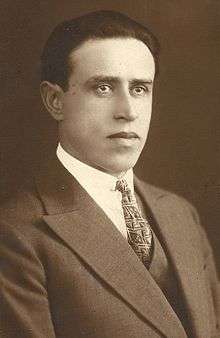Jacob Levy

Jacob Meyer Levy (Hebrew: יעקב מאיר לוי Ya'akov Me'ir Levi; May 14, 1894 – September 8, 1956) was an Israeli educator, historian, translator and writer.
Biography
Born in the Ukrainian village of Nesolon (then in the Russian Empire) to a religious Jewish family. At the early age of 12 he was studying at the Novograd-Volynsky Yeshiva (usually attended by much older students) but at the age of 19 he became an ardent Zionist and immigrated to Ottoman Palestine.[1] In 1914 he enrolled at the Herzliya Hebrew Gymnasium, where he studied for two years (grades X and XI). In 1916, presented with the choice of becoming an Ottoman citizen or being deported back to Ukraine, he chose the former and was promptly drafted into the Ottoman army and sent, along with his classmates, to officers' school in Istanbul. Following World War I he led a school for abandoned children, war orphans in Turkey. In 1925, after completing his studies at the Sorbonne in Paris, he was invited by the Jewish Consistory of Bulgaria to be the superintendent of the Jewish schools in Bulgaria.[2] At the end of his term he returned to Paris to continue his studies and in 1935 received his PhD in educational psychology from the Sorbonne. In addition to education-related essays published in professional journals such as "Hed Hachinuch" (הד החינוך), he published short stories (under the pseudonym "Aaron Aharoni") in the most important Hebrew periodicals of the period: Y.H. Brenner's "HaAdamah" (האדמה), Joseph Klausner's "HaShiloach" (השילוח) and Jacob Fichman's "Ma-abarot" (מעברות).
Between 1938 and 1956 he was the editor of "Hachinuch" (החינוך) – the Pedagogy and Psychology quarterly of the Israeli Teachers Association and during that time he published many books, including "Israel Ba-Amim" ("Israel Among the Nations") – a series of history textbooks used extensively in Israeli schools, especially in the kibbutz movement. He was an editor of the Encyclopedia Chinuchit" (Educational Encyclopedia אנציקלופדיה חינוכית) and published a series of teacher training books – "Guides" to elementary school grades.[1] His children: From his first wife Shoshana Taborovsky-Tavor) a son: Amnon (1918–1995) and from his second wife Shoshana Itygin a son: Avinoam (B. 1945).
His work
Dr. Jacob Levy published numerous books. The most important ones among them: a series of history textbooks (in five volumes) and the translation of four of French-Jewish philosopher Henri Bergson's books into Hebrew.
In writing his history textbooks, Dr. Levy's viewpoint was that studying historical dates is less important that learning the processes that led to historical events. Indeed, in his series "Israel among the nations" one could hardly find dates and history is told in a narrative, compelling way.
Books by Dr. Jacob Levy
- Maitres et Éleves Paris, 1935
- Israel Among the Nations (ישראל בעמים) (five volumes) Tel Aviv, 1948–1956; 1970
- Teaching Hebrew Penmanship (לשאלת הוראת הכתיב העברי), (with Moshe Birman), Tel Aviv 1945
- Teaching Hebrew: Methodology for Grades 1–2 Jerusalem, 1951; 1957
- Jean-Jacques Rousseau (ז'אן-ז'אק רוסו), Tel Aviv 1952
- 1st Grade Teacher's Guide (מדריך לכיתה א), Tel Aviv 1953
- 2nd Grade Teacher's Guide (מדריך לביתה ב), Tel Aviv 1954
Translations (into Hebrew) by Dr. Jacob Levy
- Le Rire (Laughter הצחוק), Henri Begson, Tel Aviv 1938; 1962; 1975; 1981
- On Dreams (Article החלום), Henri Bergson, Jerusalem 1940
- Le jugement moral chez l'enfant (The Moral Judgment of the Child השפיטה המוסרית של הילד), Jean Piaget, Tel Aviv 1940
- L'Energie spirituelle (Mind-Energy אנרגיה רוחנית), Henri Bergson, Tel Aviv 1944
- L'Evolution créatrice (An Introduction to Metaphysics מבוא למטפיסיקה), Henry Bergson, Tel Aviv 1947
- La Pensée et le mouvemant (Thought & Motion מחשבה ותנועה), Henri Bergson, Jerusalem 1953
References
| Wikimedia Commons has media related to Jacob Levi. |
- 1 2 Book (in Hebrew):Encyclopedia of the Founders and Builders of Israel, pages 2558–2560.
- ↑ Book (in Hebrew):Albert Romano, Jewish community of Bulgaria, Encyclopedia of diaspora, Jerusalem, Israel, 1967, pages 418, 479–480.